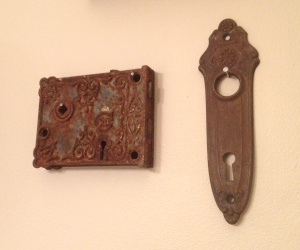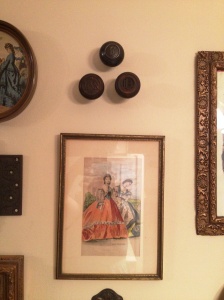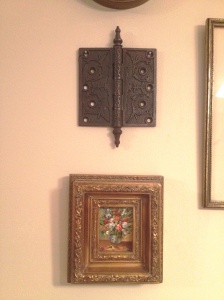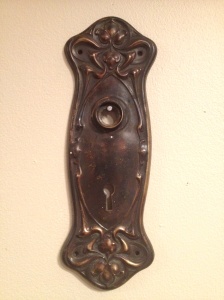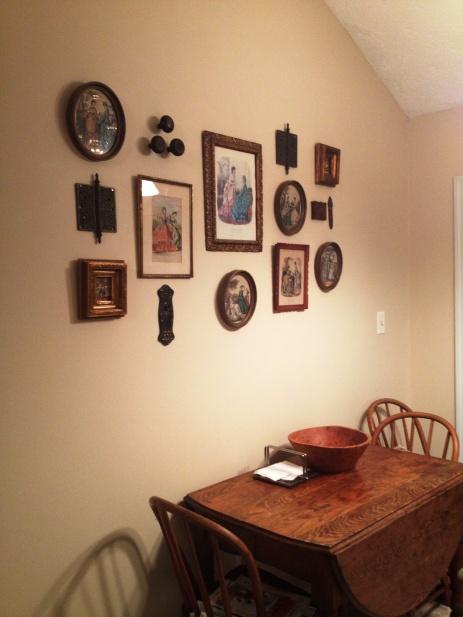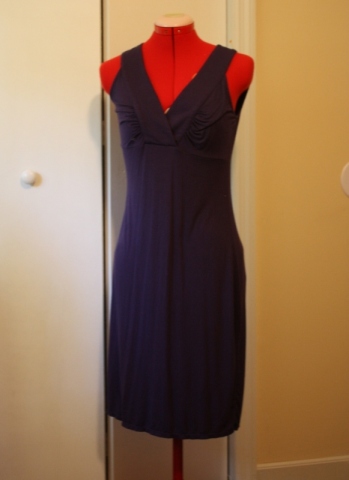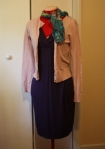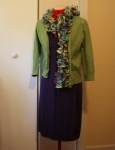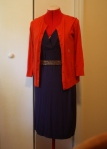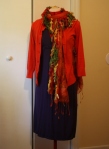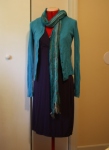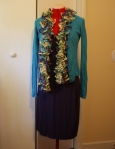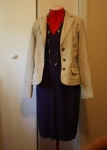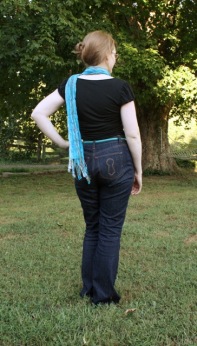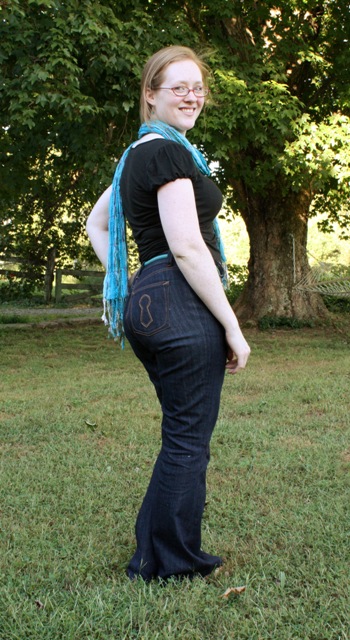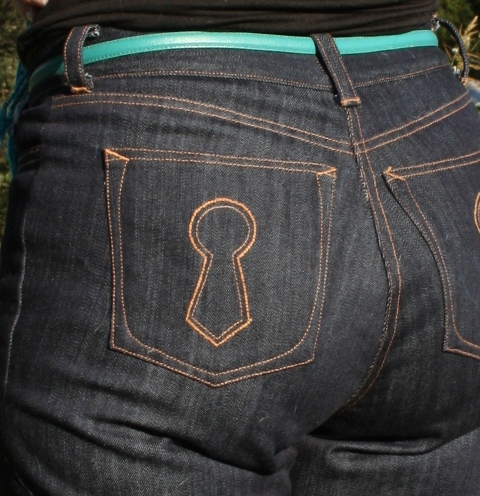I am pleased to announce that, after hours of research and experimentation, I have finally found what I consider to be the perfect solution to my years-old question of “how do I organize my sewing patterns??”
The quick answer: Evernote. For a more detailed explanation, keep reading.
I have over 500 sewing patterns (432 cataloged at present, not counting the ones I found that I somehow had forgotten to catalog, and I just bought a box of, oh, maybe 85 or 90 more a couple weeks ago because they were an incredible bargain). After coming home with those 85-90 new patterns, I decided that I had to do SOMETHING.
Previously, I had tried using a Microsoft Works database — Microsoft, however, decided to discontinue Works, so I had to go through an arduous process to convert my database to Excel. In that arduous process, I lost some information (can you see my lovely size “41386” on the vintage Bridal Elegance pattern below? Yeah, I don’t know what that means either. It actually said something back when it was in Works).
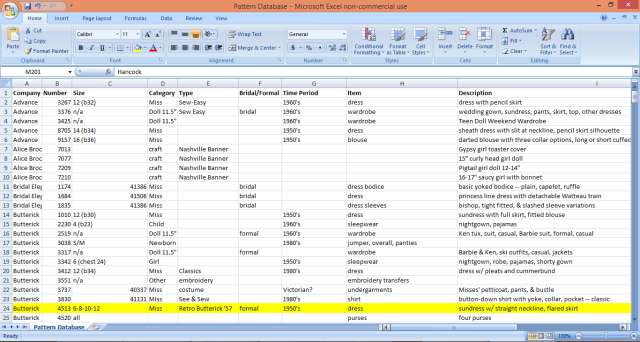
My Excel sewing pattern database.
But here’s my problem: I’m a very visual person, and the description “dress with pencil skirt” means very, very little to me. And that was all I had in Excel. So any time I wanted to find a pattern, I went and dug through boxes. Lots of boxes. Five hundred patterns’ worth of boxes.
I experimented with several different options in my search for pattern inventory nirvana. One of the first things I tried was Pattern-File. They have a very cool program, and it has a great feature whereby you can enter a pattern number, and (most of the time) it will pop up the pattern and enter it for you. This saves a LOT of time. The drawback for me, however, is that I’m a grad student on a grad student budget; while Pattern-File is very reasonably priced ($4.99 per month), I don’t like being tied into another monthly or annual bill. The other drawback, for me, is that I’m a bit of a control freak, and I like to be able to include all the information; as of February 2014, Pattern-File has no feature to list where a pattern came from or how much you paid, and the inclusion of that information was important to me (I love being able to look at my records and say, “Oh, look, Mrs. Peggy gave me that one! I had forgotten that!”). So I kept looking.
After several evenings shirking homework to research this problem, I downloaded Evernote. It’s a very versatile program, it’s free (up to a point — I’ll explain that shortly), and it automatically backs up your stuff online every few minutes. It’s also saved to your computer, though, so you can do everything offline if necessary. Evernote can be accessed anywhere, and can be synchronized with a smartphone. So if you’re in the fabric store and Simplicity patterns are 99 cents and you can’t remember what you have, you can look it up very easily. Evernote is very intuitive and easy to use, and has great search capability.
You can upload up to a certain number of megabytes per month, or pay $4.99 per month to upload up to 1gb per month. Normally, I think the basic free version will be quite sufficient; right now, though, since I’m uploading so many patterns, I bought one month of the premium version. I believe it’s a bargain. Once the data has been uploaded, they store it for you; it’s just the uploading itself that counts towards your monthly quota. Once I’m done entering the patterns and just enter the few that I buy every month or two, I should be just fine with the free version.
Here’s a screenshot of my Evernote account as it looks right now on my computer:
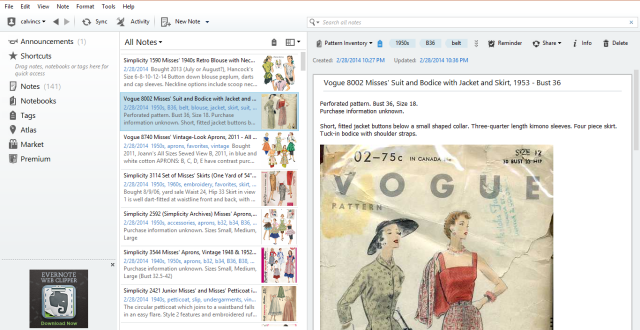
Evernote pattern database.
When processing a pattern, I enter the title (company, pattern number, pattern title, date, and size), add all my purchase information (when, where, from whom, and how much I paid), typically add the brief description of the pattern from the back, and then add a picture of the front and back of the pattern. Evernote has this great feature whereby you can drag a picture from any website directly into your “note,” and it will save it for you. So I just do a Google search for, say, “Vogue 8002,” and then drag in the picture. If it’s a pattern that’s still available, it’s even easier; you just drag the pictures and yardage requirements from the manufacturer’s website. Some manufacturers include their yardage as PDFs, and that’s okay too — you can attach the PDF in Evernote and it will show up just like a picture. The last thing I do is add tags, which help with searching. This Vogue 8002, for instance, is tagged with the following: “B36, vintage, suit, 1950s, belt, blouse, top, skirt, jacket, favorite.” If I search for any one of those terms — or any of the words in the pattern description — Evernote will find all the patterns that match it. Tags could also be utilized to aid in pattern organization (i.e., “Box 1, Box 2”), but I haven’t gotten that far yet.
Another helpful feature of Evernote is that you can divide it into different “Notebooks.” I currently have one notebook for all my patterns (I felt that, since Evernote is so search-friendly, only one notebook was necessary), and a second notebook for cataloging my historic photographs that I’m using for research (I buy a photo on eBay, drag the picture from the eBay listing over into Evernote, and there it is).
But back to the patterns — if you’re thorough in making sure you have all the yardages and other information entered, you could also take your Evernote with you to the fabric store. This way, when you find that perfect fabric, you know exactly how much you should buy — and what size zipper it wants.
By the way, if you decide you want to try it out, I’d be very happy if you use my link from this page — I’ll get a month of the Evernote Premium free if you decide to try it out through the link. (I would like to note, however, that I discovered this AFTER deciding to write this article — I was writing it anyway, and that was just a nice little bonus!)
All in all, I’m perfectly thrilled my new system. It might even make me finally break down and get a smartphone.
UPDATE 3/26/14: I just discovered that you can show folders publicly by sending anyone a link — pretty fantastic feature if you want to show your friends which patterns you’ve got. 🙂
UPDATE 1/11/19: Another fabulous thing about Evernote is that you can sync it among multiple devices. My patterns live in my computer, my phone, and my iPad, which makes it easier to do fabric shopping on the go!
